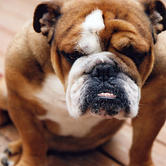Does Your Bulldog Pee When Excited or in Trouble? How to Solve the Submissive Urination Problem

So you’ve brought home an adorable puppy and it’s been a couple of months. Your pup goes potty outside the house when it’s time to, but it also does something else inside the house. An odd type of peeing. Sometimes it’s a walking pee, sometimes it’s standing still. Sometimes it’s when you try to discipline the puppy and other times it’s when you’re happy with the puppy. You’re completely confused and can’t make sense of it.
Fret no more. You’re about to find out what it is and what you can do to fix it.
What is it?
What your puppy is doing is something called submissive urination. It’s pretty common, and even more common in females of the breed. It’s also completely manageable and not a physical health issue, but rather a confidence issue. By urinating when excited or feeling threatened, your puppy is expressing to you its understanding that it is submissive and you are dominant. It’s completely innocent and meant in good nature, much like rolling over onto its back. This is just a different form of body language.
Why Isn’t My Training Working?
When your puppy submissively urinates you probably do what any owner would do, and get frustrated and tell him/her no. This is a completely natural reaction for humans, but unfortunately your puppy takes it the wrong way. Because your pup understands that it’s telling you good things, it will only think that you don’t understand (which, you don’t) and try harder, by peeing more often. Traditional training doesn’t cure this problem, and in fact only makes it worse for this reason.
So, How Do I Fix It?
Well, your puppy is doing this due to feeling vulnerable either in excitement or trouble. So the fixing is in the confidence building of your pup to help it feel more secure. There are some simple things you can do to help:
1. Refrain from yelling for and at your pup. Work on keeping a consistent, calm, tone for both good and bad behavior, and teach your dog based on commands rather than the tone that gets him/her feeling insecure.
2. Spend more positive time with your pup. Show him more affection and positive attention.
3. Use proper body language that your puppy will understand. Instead of petting on the head, stroke under the chin. Get down on the floor with your pup more often to get on its level. This helps it to feel like you’re not so large and domineering.
4. Avoid eye contact. Holding eye contact is you proving your dominance. When your puppy sees this, he will agree with you by urinating.
5. Let the pup come to you instead of you going to it as often as possible. This can’t always be avoided, but it will help to train with treats, and run around and have your pup chase you (make it fun.)
6. You can still tell your puppy ‘no,’ but don’t hold grudges or otherwise offer harsh punishments. Be strong in your statements to successfully communicate your displeasure, but keep it very short and calm when correcting the pup. Always follow up with something positive.
7. Don’t punish your pup for peeing. You can say “no” and take it straight outside like normal potty training routing. It’s impossible to not be frustrated, but try your best to mask it.
8. Socialize your puppy very well both in and outside of the house. Having natural social situations and interactions will help to build its confidence.
Overall you want your puppy to become more socially confident, and trust you more. Do this by socializing, not holding grudges or being harsh, and being consistent. You always want to show your puppy more love and affection than anger and resentment. Your submissive urinating pup is very sensitive to your displeasure, so you’ll have to work extra hard to make sure it doesn’t have terrible effects.
Photo credit: sabianmaggy/Flickr







